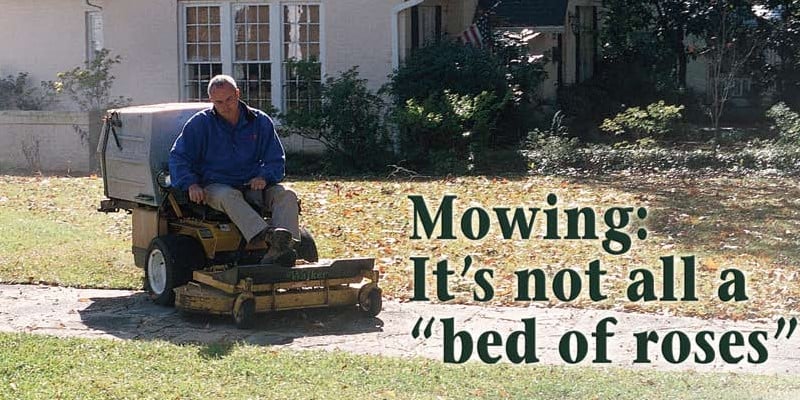When asked about mowing in tough conditions, Kim Kellogg, co-owner with wife Char of Grasshopper Property Maintenance in Millersburg, Ohio, gives this reply: “There are no rainy days, there are no sunny days. There are only mowing days.” Rain or shine, the crews and their mowers have to get the job done, he adds. “It’s all about the equipment and the motivation of your crew. Whether catching or sidedischarging the grass, the Walkers do a great job when the lawns are wet, high and hilly.”
 That’s a great testimonial for a machine that is designed to mow in commercial applications even when Mother Nature, the terrain and mowing crews are not necessarily on the same page. Char Kellogg adds these thoughts about spring mowing, especially this year when the Midwest and East have received more than their share of rain.
That’s a great testimonial for a machine that is designed to mow in commercial applications even when Mother Nature, the terrain and mowing crews are not necessarily on the same page. Char Kellogg adds these thoughts about spring mowing, especially this year when the Midwest and East have received more than their share of rain.
“Despite the wet spring, we are not behind… at least in our mowing. Some of the guys carry raincoats with them, while others don’t mind getting wet. They are always ready to get back at it as soon as heavy rain lets up.”
Char continues, “Real-time radar gives us real-time warning of what’s approaching, and helps us manage crew placement and scheduling. It helps us decide if we call the guys off, bring them in late in the morning, send them home early, or have them sit in the trucks to wait out a storm if it is a heavy rain or there is thunder and lightning. The radar also helps us anticipate the rest of the week. If it looks like a wet one, we add extra people to the crews or add another crew.”
Char hits the proverbial nail on the head when she says, “This isn’t an industry for sissies.” She gives the following example. “In early April of this year we mowed all day, then crews put the plows and salt spreaders on the trucks and we plowed snow all night. We have actually pushed snow with our Walker Mowers when occasionally we have been caught in a snowstorm while mowing.”
Mowing in a snowstorm would be the extreme, and something most Walker users may never experience. Unless you mow in Perfect Town, USA, though, you have experienced and will experience mowing in tough conditions where the grass may be too wet, too high or too dry. There may be other occasions, too, when, ideal mowing conditions are compromised by having to operate on slopes or near embankments.
Yet, as Char points out, this isn’t an industry for the faint of heart. Instead, it’s an industry in which mowing contractors need to be aware of mowing conditions and operate their machines to accommodate them. This is an axiom no matter what brand or type of mower you operate. The following are guidelines to help operators cope with difficult mowing conditions in a safe and productive manner.
Wet, Tall or Dry grass
Mowing contractors don’t like to mow in wet grass, yet it is often necessary to do just that to stay on schedule and keep customers satisfied. When mowing in these conditions, operators may experience “clumping” with side-discharge decks or “clogging” with catcher or grass-handling decks. Both problems can be caused or magnified by cutting too low (restricting airflow under skirt of deck), mowing too fast (excess volume of clippings), and failing to maintain maximum engine revs, which reduces the ability of the blades and deck to either discharge or vacuum the grass.
Walker users can minimize GHS deck clogging by using an optional catcher exhaust screen with larger holes. To maintain maximum clog resistance, they should also review the clogging checklist in their Walker Owner’s Manual.
Problems caused by wet mowing conditions do not end at the discharge chute. Wet turf is easily damaged, especially when making a zero- or tight-turn. Before making turns in these conditions, slow your ground speed and observe proper turning techniques.
Mowing dry grass or leaves creates a different set of challenges for operators. Here, it is less a question of mowing speed and technique, and more a question of awareness. For example, in dry conditions operators should frequently inspect for and clean out any dry material that has collected around engine parts. They should also avoid overfilling the grass catcher. Overfilling a catcher may cause excess dry material to contact hot engine parts. Because piles of dry grass and leaves can be combustible, avoid backing or driving the mower into them.
A rule of thumb to follow in wet, dry and normal mowing conditions is to empty the catcher completely at the end of the day. Storing either wet or dry material in a catcher is a hazard.
There are also times when mowing contractors will be asked to mow overgrown grass. Before attempting the job, walk the area looking for hidden hazards such as holes, debris and soft or unstable ground. Make the first cut with the mowing deck set at its highest cutting height. Then, mow again, lowering the deck.
Hills, Embankments and Water
Mowing operators need to be especially cautious when mowing slopes and hilly areas. Some hills are too steep for riding mowers and some are even too steep for walk mowers. Use your best judgment and play it safe when deciding to use a rider or walk-behind mower or when to use a growth retardant to control grass growth.
When mowing steep areas with any riding mower, slow down and use care, especially when maneuvering, starting and stopping. In addition, avoid sharp turns or sudden changes in direction. (Note: The maximum recommended side slope operating angle for Walker Mowers is 20° or 33% grade; see your Walker Owner’s Manual for an illustration.)
Always be on the lookout for holes, too, when mowing on slopes. Dropping a wheel into a hole can cause tipping and rollover.
Despite the fact that a Walker Mower can always be stopped in an emergency by simply pulling the Forward Speed Control to the Neutral-Park position, operators should know and practice emergency stop procedures. Understanding how to stop the mower is especially important when operating on slopes. For example, a broken transmission drive belt can cause the mower to freewheel down the hill until the Forward Speed Control is moved to the Neutral-Park position. You can practice this emergency stopping procedure by removing the drive belt on a slope to simulate belt failure.
Caution must also be observed when mowing near an embankment or water. Before mowing, walk along banks to check ground stability, and avoid mowing in soft/unstable areas. Never mow close to the edge of an embankment, pond or other water. Instead, have a margin of safety of at least one machine length from the bank. Use a trimmer or walk-behind mower to trim out areas along a bank.
There are two additional important considerations when mowing near embankments and water. First, avoid backing down a slope toward potential hazards. Using this maneuver to dump grass clippings is especially dangerous. Then, when stopping near an embankment or water, always engage the parking brake.
No, mowing isn’t all a bed of roses. But there are ways to safely and productively get the job done despite uncooperative weather and other difficult mowing conditions. Again, be aware of the conditions and operate your mower to accommodate them.







 Site Search
Site Search



